Not many teams in La Liga, or in the world for that matter, can proudly say that they have beaten Real Madrid every time the Galacticos visited them in the last four years. One such team is Sevilla and coming into the match on Sunday, they were definitely the favourites.
But Zinedine Zidane’s troops somehow pulled through and salvaged a narrow 1-0 victory on the night that propelled them to the joint top spot in the table. This tactical analysis will examine both team’s tactics and tell you just how Real Madrid got the better of Sevilla.
Lineups
Zidane didn’t really experiment too much or at all since his last bout with Paris Saint-Germain in the Champions League. Even though that team lost 3-0 to the French titans, only the returning Sergio Ramos was a new name on the team sheet come Sunday evening. Los Blancos were deployed in their standard 4-3-3 formation.
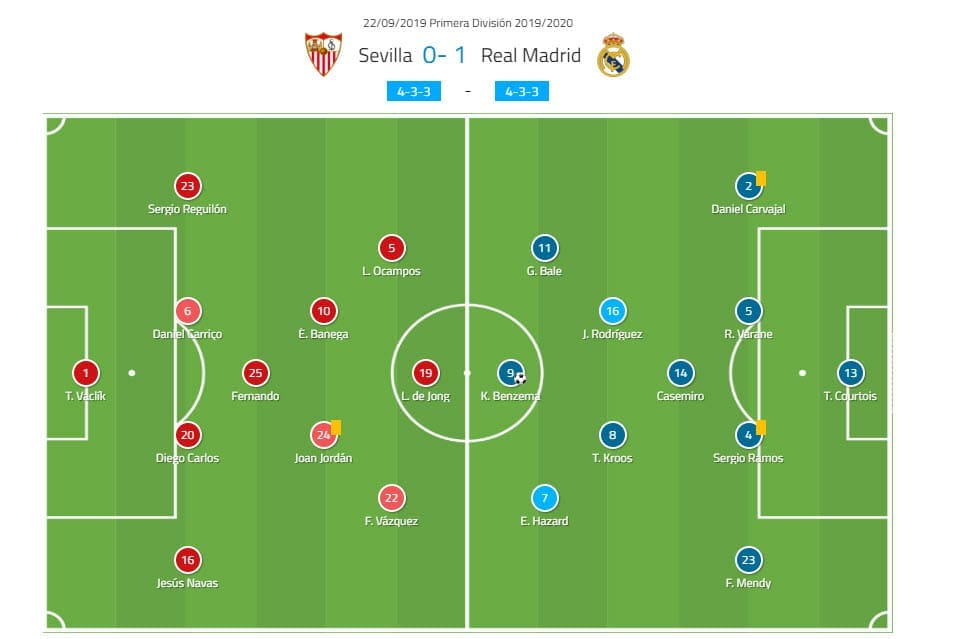
Sevilla and Julen Lopetegui, on the other hand, made wholesale changes to their tactics and lineup, returning Luuk de Jong into the starting XI alongside Lucas Ocampos and Franco Vázquez. Real Madrid loanee, Sergio Reguilón returned to the left-back position while Jesús Navas manned the other flank.
Éver Banega and Fernando also returned to the starting lineup alongside Joan Jordán in the middle of the pitch as the Andalusian team was deployed in a 4-3-3/ 4-1-4-1 system. We’ll now go into a more detailed analysis of both team’s tactics.
A highly disjointed game
Even though this was looking likely to be a really intense clash between two attacking sides, both Real Madrid and Sevilla had certain troubles building their play and stabilising their attacks. For that reason, we saw a lot of interruptions and breaking up of the flow as both sides were sloppy in possession.
The home team registered 93 losses on the night while their guests recorded even more – a total of 102. Still, even though Sevilla had more recoveries and fewer losses, it felt like Real Madrid still made the most out of their tally.
When out of possession, the Galacticos would systematically press Sevilla, often switching through a 5-4-1 and 4-1-4-1 system and then upon certain pressing triggers getting activated, they would push forward and try and mirror the opposition’s approach.
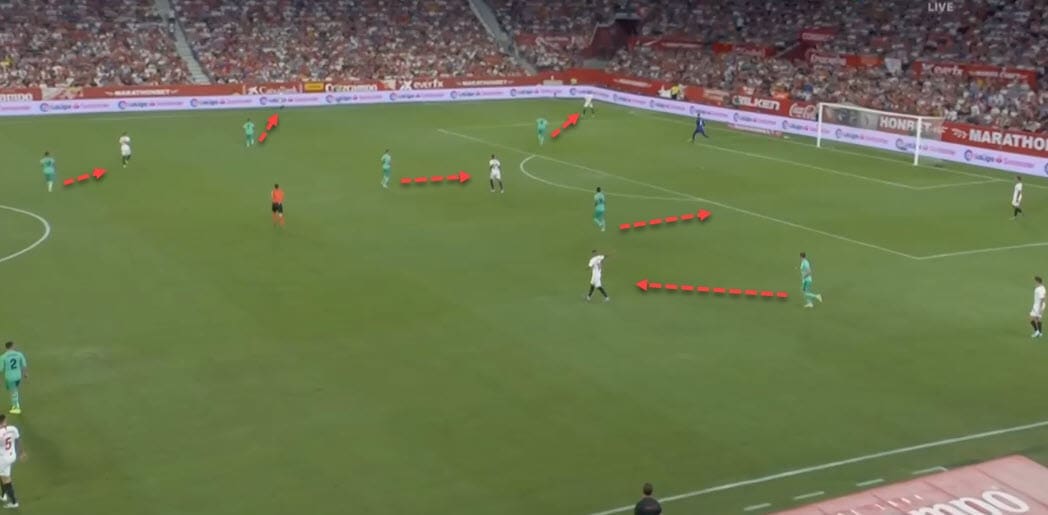
Granted, that did not always yield them the wanted results as their pressing traps were not executed properly. When and if Sevilla were given enough space, the home team would try and build from the back, which is the trademark of Lopetegui’s tactics. But generally, they were mostly out of sorts and out of clear ideas when it came to the offensive approach.
The Andalusians were overly reliant on their crosses throughout the match and all of their attacks gravitated towards either of their flanks. The goal was to create overloads, both in attack and defence. Notice below how that translated onto the pitch.
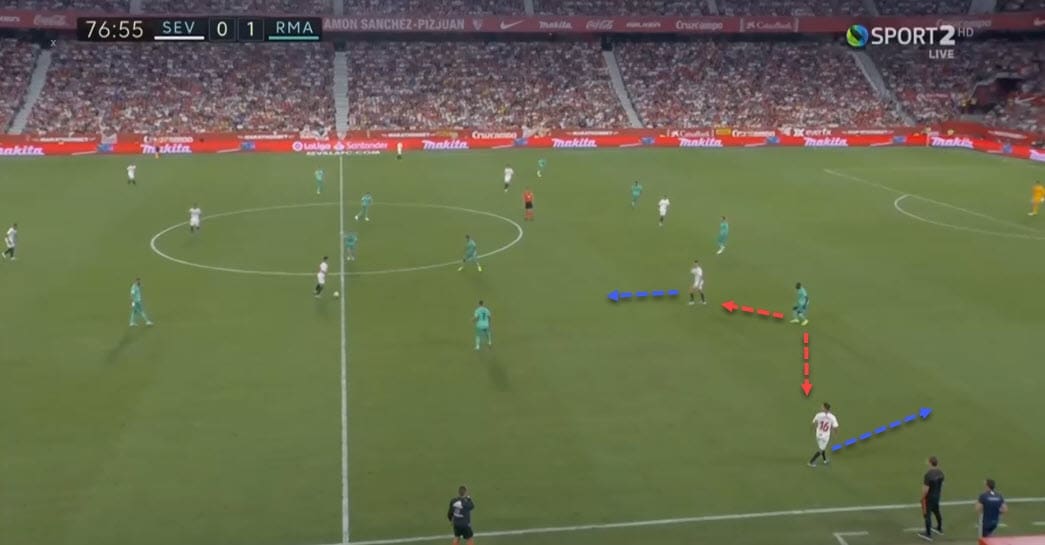
Their full-backs would provide width at all times, pushing forward and linking up with the forwards. Notice above how Navas is extremely high and wide and the forward consequently drops in between the lines to force Mendy to choose between two players to mark.
This gives the ball carrier two options and one is always open in these scenarios. Sevilla would often use these overlaps to get in behind Real Madrid’s defence. Let’s examine another example in the image below.
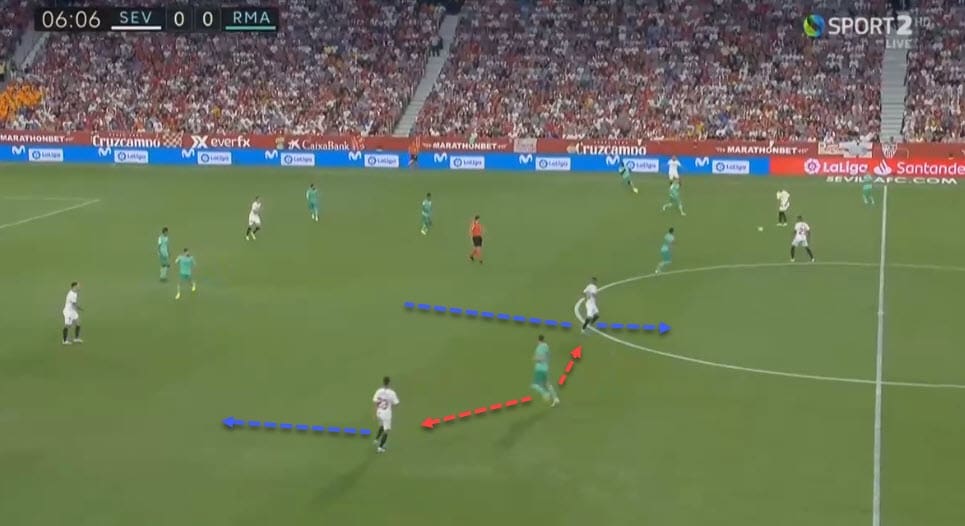
Banega drops deeper to assist the build-up and despite Gareth Bale tracking back to cover the potential overlap, he still has to choose who to mark which ultimately gives Sevilla access to their flanks.
Unfortunately for them, their overreliance on crosses did not yield any kind of result in the end despite some of their most dangerous attempts coming directly from either a cross or a set-piece into the box.
At the end of the night, they registered a total of 33 crosses but only ten were accurate. Subsequently, the highest xG they recorded on the night from positional play came from the flanks, as can be seen in the graph below.
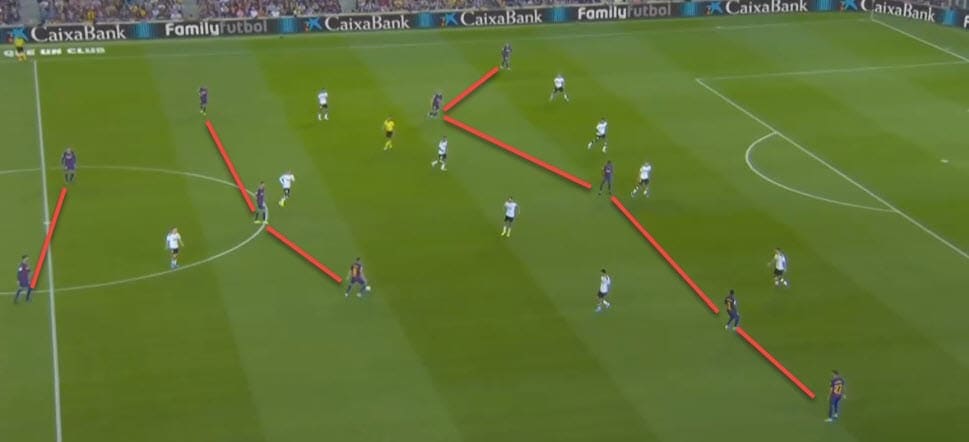
Sevilla’s defensive tactics
When defending, Sevilla had a clear plan. Just like they seemed to fancy the wings when attacking, a similar thing happened when they were defending. Seeing how Real Madrid had constant individual threats like Eden Hazard and Gareth Bale manning the left and the right flanks respectively, plugging those holes was essential for the hosts.
The idea was to create overloads and battle Real Madrid’s individual superiority with a numerical advantage. At all times, midfielders would work with their full-backs to put pressure on Los Blancos’ players and stop the potential interchanges and overlaps.
Notice below how that looked like on the pitch.
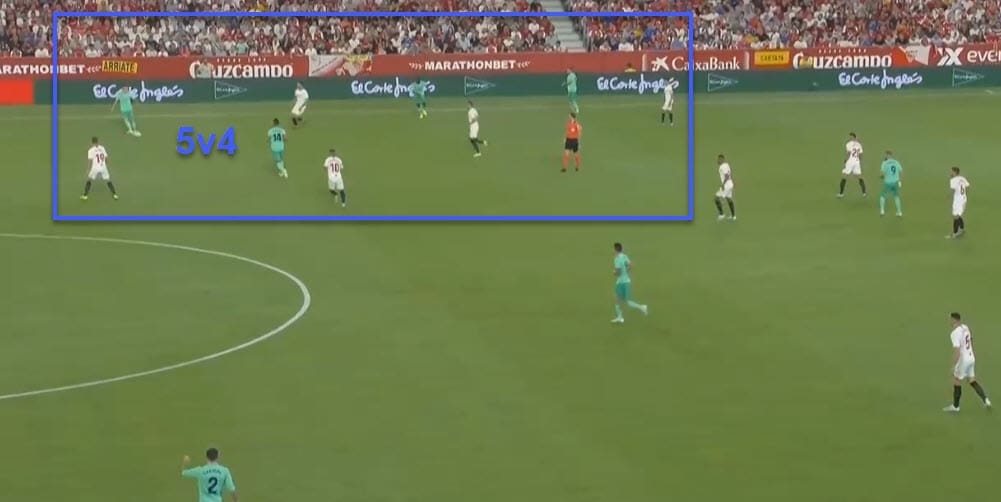
All three lines of Sevilla’s team are in action in that single screenshot: the midfielders and the defenders overload the whole flank, stopping the ball circulation and progression going forward while the forwards get ready to burst into Real Madrid’s territory and chase the stray ball once the visitors are forced back.
Even though it didn’t always result in a snatched ball, it did stop Real Madrid from building their attacks successfully. Of course, it didn’t take long for Zidane’s troops to recognise these specific tactics so they battled numerical inferiorities with bodies of their own.
Often we could see various players dropping out of their designated positions in order to help the build-up or just bypass the press of the opposition. Benzema would regularly slide into the wings to combine with either Bale or Hazard, as can be seen below.
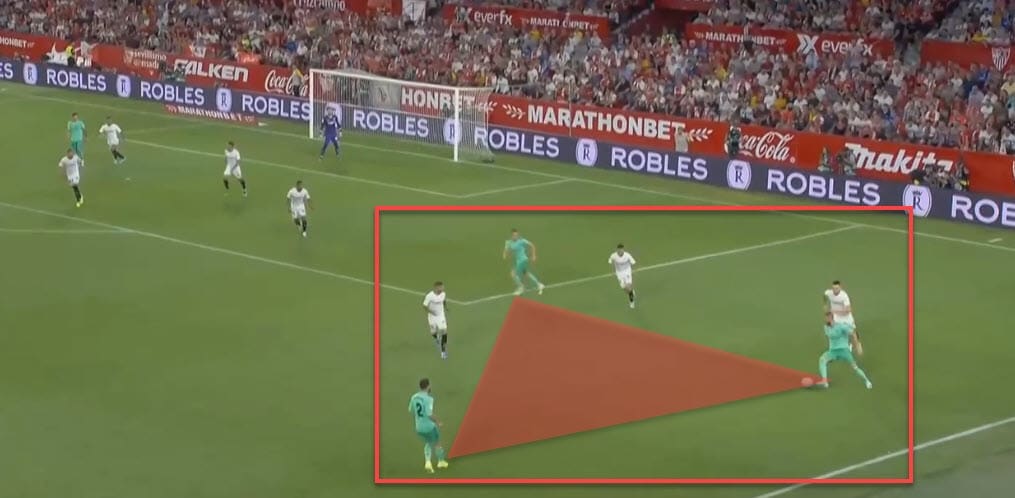
Carvajal would often push forward with an aim to link up with Bale but they would almost always meet with multiple Sevilla players who intended to cover the whole flank. To avoid that from happening, Benzema would drop wide to balance the numbers and allow Real Madrid to keep circulating the ball.
A similar thing would happen in instances when the Andalusian team decided to press the Whites. Bale would, in that case, drop just slightly deeper and combine with his midfield and defence in order to get the ball to safety. Below, Real Madrid once again use their numerical superiority to escape the press.
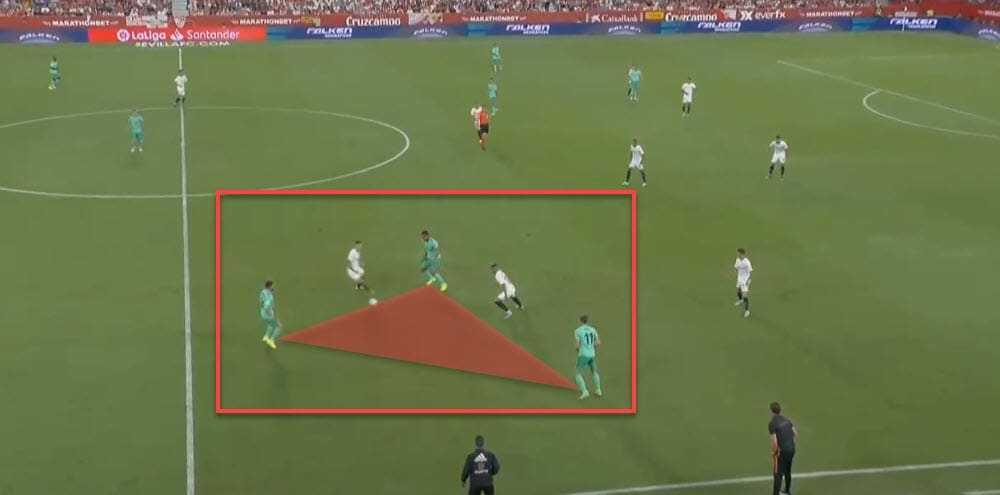
Sevilla often deployed their collapsing tactics switching from a zonal to heavy man-marking depending on the situation. Their system followed suit: out of possession, we would generally see them in a 4-4-2 formation but upon pressing their opposition this would change shape accordingly.
Real Madrid successfully create space
Both teams were on somewhat equal footings throughout the game and neither side seemed to really take hold of the clash. But one thing Zidane did improve upon, at least in this particular game, was space creation.
Too often would we see Real Madrid’s midfield disjointed and not combining well but on Sunday, they showed some good signs of communication and movement that led to good chance creation.
Los Blancos often keep a rather high defensive line and they start their attacks from the back, either through long balls or simply through a patient build-up. The way they played around Sevilla’s defensive block was through movement and subsequent moving of the opposition’s pieces.
Notice below how Toni Kroos drops just slightly deeper in order to create a triangle with Sergio Ramos and Casemiro. This pulls Sevilla’s defender away and creates a passing channel to advance the ball into a free player.
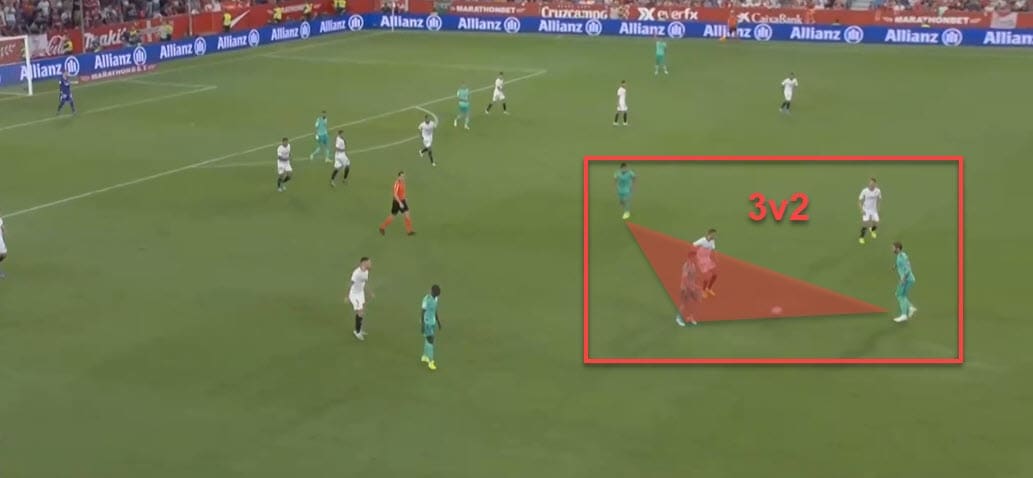
Similarly to that, here’s another example of how a seemingly simple movement and combination around the centre of the pitch creates space for other Real Madrid players who can then progress the ball forward.
Once again it’s the same setup with two midfielders combining with Ramos while Casemiro runs into space to receive the ball after Sevilla’s pressing duo has been bypassed.
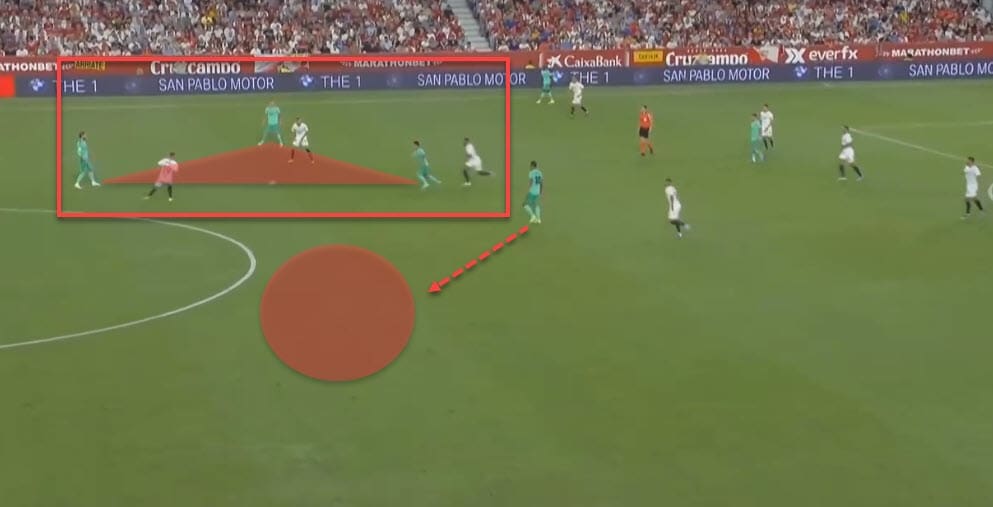
The Brazilian then carries the ball to the other flank, dragging another marker with himself and leaving James Rodriguez all alone and with acres of space and more importantly, enough time to figure out where to put the ball.
A quick combination with Carvajal gets the ball quickly to the Colombian who has enough space to turn, spot Hazard and deploy the pass into the final third.
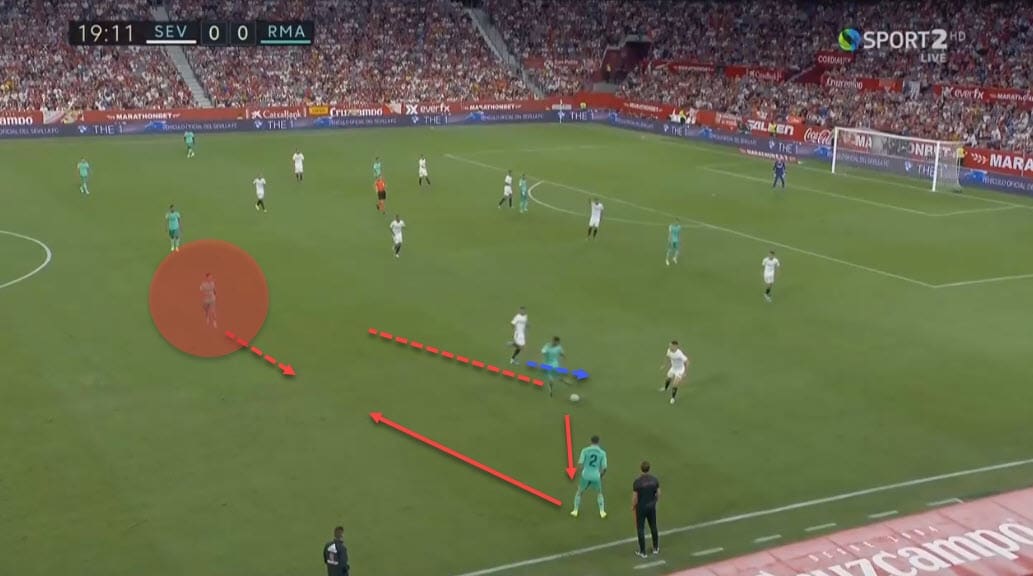
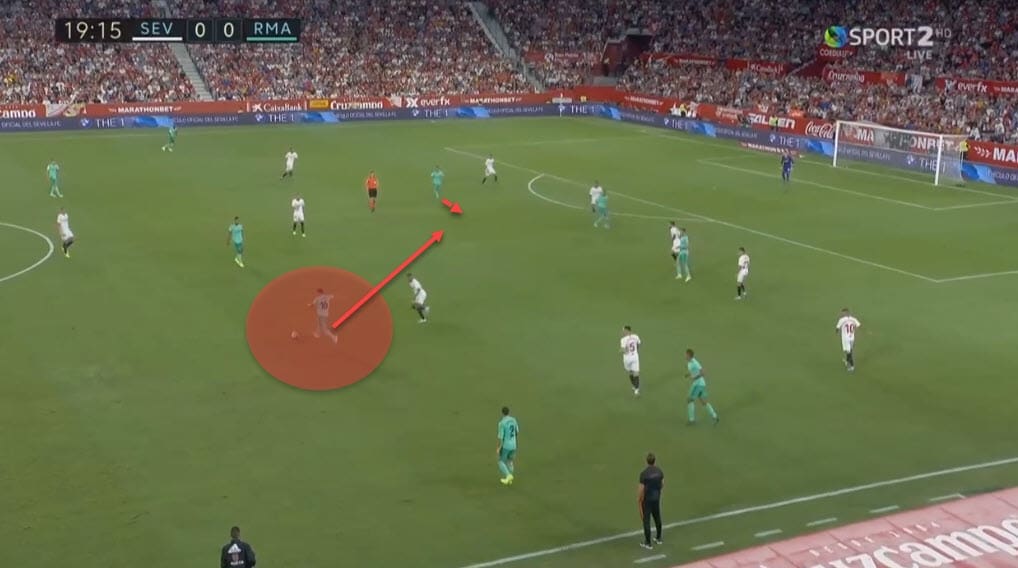
The only goal of the game came courtesy of Benzema’s header marking his fifth goal in five La Liga games for Real Madrid this season. That goal, however, was a combination of bad defending and Los Blancos’ good use of movement and space.
Once Carvajal is found escaping his marker on the right, he sends a brilliant cross to his French teammate who finishes it off with a subtle and yet deadly touch.
Conclusion
Even though there’s been a lot of talk about Real Madrid’s supposed crisis and Zidane failing to bring them back to life, they are still ahead of both Barcelona and Atlético Madrid in the standings.
It might have been a rocky start but maybe this triumph over Sevilla proves to be a start of something beautiful for the Galacticos.

If you love tactical analysis, then you’ll love the digital magazines from totalfootballanalysis.com – a guaranteed 100+ pages of pure tactical analysis covering topics from the Premier League, Serie A, La Liga, Bundesliga and many, many more. Buy your copy of the August issue for just ₤4.99 here






Comments